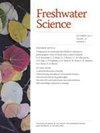营养限制对入侵鱼类抑制的反应:尸体和类似颗粒物如何改变外周生物
IF 1.6
4区 环境科学与生态学
Q3 ECOLOGY
引用次数: 3
摘要
在美国怀俄明州黄石国家公园黄石湖,原生的黄石切喉鳟鱼(Oncorhynchus clarkii bouvieri Jordan and Gilbert, 1883)种群数量正在下降,因为来自引进的入侵湖鳟鱼(Salvelinus namaycush Walbaum in Artedi, 1792)的竞争。刺网用于抑制成年湖鳟鱼;然而,人们正在开发抑制胚胎的方法,包括在产卵地点添加湖鳟鱼尸体和类似尸体的颗粒。分解尸体和类似颗粒导致溶解氧浓度降低,从而导致湖鳟鱼胚胎死亡,但这些方法对初级生产者的影响尚不清楚。我们在3个产卵地点放置了原位营养物扩散基质(NDS)。第1个点用尸体处理,第2个点用模拟颗粒处理,第3个点没有处理(对照)。为了估计抑制措施如何改变营养限制,我们在每个站点测量了6种NDS修正中的藻类生物量:无(对照)、N、P、N + P、地面尸体或粉碎的模拟颗粒。在处理整个位点之前和之后,我们在每个位点部署了每种修改的5个重复。产卵地点在尸体前添加氮磷共限外植体或模拟微球(P < 0.01);然而,在产卵地添加营养物质后,营养物质并没有受到限制(p = 0.31-1)。整块胴体处理后藻类生物量提高4倍。相比之下,模拟颗粒似乎抑制了修正案(处理后对照场地NDS的20%)和处理地块(模拟颗粒场地预处理生物量的33%)中的藻类生物量。我们还测量了模拟颗粒中的单个成分如何改变周围植物生物量,这表明维生素E、雌激素和豆油成分降低了初级生产者的生长。抑制方法可能刺激或减少藻类生物量,这取决于所使用的方法,这可能对食物网产生级联效应,并可能降低控制措施的成功率。估计不同的湖鳟鱼抑制方法如何改变黄石湖沿岸地区的基础资源,将有助于自然资源机构制定有效的计划,在生命早期控制入侵掠食者,同时尽量减少对生态系统的改变。本文章由计算机程序翻译,如有差异,请以英文原文为准。
Response of nutrient limitation to invasive fish suppression: How carcasses and analog pellets alter periphyton
The native Yellowstone Cutthroat Trout (Oncorhynchus clarkii bouvieri Jordan and Gilbert, 1883) population in Yellowstone Lake, Yellowstone National Park, Wyoming, USA, is in decline because of competition from the introduced, invasive Lake Trout (Salvelinus namaycush Walbaum in Artedi, 1792). Gillnetting is used to suppress adult Lake Trout; however, methods are being developed to suppress embryos, including adding Lake Trout carcasses and carcass-analog pellets to spawning sites. Decomposing carcasses and analog pellets cause decreased dissolved oxygen concentrations thereby leading to Lake Trout embryo mortality, but the effects of these methods on primary producers are unknown. We deployed in-situ nutrient diffusing substrates (NDS) at 3 spawning sites. The 1st site was treated with carcasses, the 2nd site was treated with analog pellets, and a 3rd lacked treatment (control). To estimate how suppression measures may alter nutrient limitation, we measured algal biomass in 6 NDS amendments at each site: nothing (control), N, P, N + P, ground carcasses, or pulverized analog pellets. We deployed 5 replicates of each amendment at each site before and after treating whole sites. N and P co-limited periphyton before carcasses or analog pellets were added to spawning sites (p < 0.01); however, nutrients were not limiting after the treatments were added to spawning sites (p = 0.31–1). Algal biomass was 4× higher after whole-site carcass treatments. In contrast, analog pellets appeared to suppress algal biomass in the amendments (20% of NDS at the control site post-treatment) and in the treatment plot (33% of pre-treatment biomass at analog pellet site). We also measured how individual ingredients in analog pellets altered periphyton biomass, which suggested that vitamin E, estrogen, and soybean oil ingredients reduced the growth of primary producers. Suppression methods may stimulate or reduce algal biomass, depending on the methods used, which could have cascading effects on food webs and potentially reduce the success of the control measures. Estimating how different Lake Trout suppression methods may alter basal resources in the littoral zone of Yellowstone Lake will help natural resource agencies develop effective plans to control invasive predators at early life stages while minimally altering ecosystems.
求助全文
通过发布文献求助,成功后即可免费获取论文全文。
去求助
来源期刊

Freshwater Science
ECOLOGY-MARINE & FRESHWATER BIOLOGY
CiteScore
4.10
自引率
0.00%
发文量
49
审稿时长
6-12 weeks
期刊介绍:
Freshwater Science (FWS) publishes articles that advance understanding and environmental stewardship of all types of inland aquatic ecosystems (lakes, rivers, streams, reservoirs, subterranean, and estuaries) and ecosystems at the interface between aquatic and terrestrial habitats (wetlands, riparian areas, and floodplains). The journal regularly features papers on a wide range of topics, including physical, chemical, and biological properties of lentic and lotic habitats; ecosystem processes; structure and dynamics of populations, communities, and ecosystems; ecology, systematics, and genetics of freshwater organisms, from bacteria to vertebrates; linkages between freshwater and other ecosystems and between freshwater ecology and other aquatic sciences; bioassessment, conservation, and restoration; environmental management; and new or novel methods for basic or applied research.
 求助内容:
求助内容: 应助结果提醒方式:
应助结果提醒方式:


